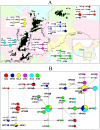Patterns of adaptive and neutral diversity identify the Xiaoxiangling mountains as a refuge for the giant panda
- PMID: 23894623
- PMCID: PMC3716684
- DOI: 10.1371/journal.pone.0070229
Patterns of adaptive and neutral diversity identify the Xiaoxiangling mountains as a refuge for the giant panda
Abstract
Genetic variation plays a significant role in maintaining the evolutionary potential of a species. Comparing the patterns of adaptive and neutral diversity in extant populations is useful for understanding the local adaptations of a species. In this study, we determined the fine-scale genetic structure of 6 extant populations of the giant panda (Ailuropoda melanoleuca) using mtDNA and DNA fingerprints, and then overlaid adaptive variations in 6 functional Aime-MHC class II genes (DRA, DRB3, DQA1, DQA2, DQB1, and DQB2) on this framework. We found that: (1) analysis of the mtDNA and DNA fingerprint-based networks of the 6 populations identified the independent evolutionary histories of the 2 panda subspecies; (2) the basal (ancestral) branches of the fingerprint-based Sichuan-derived network all originated from the smallest Xiaoxiangling (XXL) population, suggesting the status of a glacial refuge in XXL; (3) the MHC variations among the tested populations showed that the XXL population exhibited extraordinary high levels of MHC diversity in allelic richness, which is consistent with the diversity characteristics of a glacial refuge; (4) the phylogenetic tree showed that the basal clades of giant panda DQB sequences were all occupied by XXL-specific sequences, providing evidence for the ancestor-resembling traits of XXL. Finally, we found that the giant panda had many more DQ alleles than DR alleles (33∶13), contrary to other mammals, and that the XXL refuge showed special characteristics in the DQB loci, with 7 DQB members of 9 XXL-unique alleles. Thus, this study identified XXL as a glacial refuge, specifically harboring the most number of primitive DQB alleles.
Conflict of interest statement
Figures




Similar articles
-
Patterns of genetic differentiation at MHC class I genes and microsatellites identify conservation units in the giant panda.BMC Evol Biol. 2013 Oct 22;13:227. doi: 10.1186/1471-2148-13-227. BMC Evol Biol. 2013. PMID: 24144019 Free PMC article.
-
Natural selection coupled with intragenic recombination shapes diversity patterns in the major histocompatibility complex class II genes of the giant panda.J Exp Zool B Mol Dev Evol. 2010 May 15;314(3):208-23. doi: 10.1002/jez.b.21327. J Exp Zool B Mol Dev Evol. 2010. PMID: 19950128
-
Reproductive Strategy Inferred from Major Histocompatibility Complex-Based Inter-Individual, Sperm-Egg, and Mother-Fetus Recognitions in Giant Pandas (Ailuropoda melanoleuca).Cells. 2019 Mar 19;8(3):257. doi: 10.3390/cells8030257. Cells. 2019. PMID: 30893784 Free PMC article.
-
Major histocompatibility complex class II variation in the giant panda (Ailuropoda melanoleuca).Mol Ecol. 2006 Aug;15(9):2441-50. doi: 10.1111/j.1365-294X.2006.02966.x. Mol Ecol. 2006. PMID: 16842418
-
Black and white and read all over: the past, present and future of giant panda genetics.Mol Ecol. 2012 Dec;21(23):5660-74. doi: 10.1111/mec.12096. Epub 2012 Nov 7. Mol Ecol. 2012. PMID: 23130639 Review.
Cited by
-
No evidence for MHC-based mate choice in wild giant pandas.Ecol Evol. 2018 Aug 1;8(17):8642-8651. doi: 10.1002/ece3.4419. eCollection 2018 Sep. Ecol Evol. 2018. PMID: 30271533 Free PMC article.
-
MHC-associated Baylisascaris schroederi load informs the giant panda reintroduction program.Int J Parasitol Parasites Wildl. 2020 May 28;12:113-120. doi: 10.1016/j.ijppaw.2020.05.010. eCollection 2020 Aug. Int J Parasitol Parasites Wildl. 2020. PMID: 32528846 Free PMC article.
-
Factors affecting genotyping success in giant panda fecal samples.PeerJ. 2017 May 23;5:e3358. doi: 10.7717/peerj.3358. eCollection 2017. PeerJ. 2017. PMID: 28560107 Free PMC article.
-
Global conservation of species' niches.Nature. 2020 Apr;580(7802):232-234. doi: 10.1038/s41586-020-2138-7. Epub 2020 Mar 25. Nature. 2020. PMID: 32269340
-
Patterns of genetic differentiation at MHC class I genes and microsatellites identify conservation units in the giant panda.BMC Evol Biol. 2013 Oct 22;13:227. doi: 10.1186/1471-2148-13-227. BMC Evol Biol. 2013. PMID: 24144019 Free PMC article.
References
-
- Hu JC (2001) Research on the giant panda. Shanghai: Shanghai Publishing House of Science and Technology.
-
- State Forestry Administration of China (2006) The third national survey report on giant panda in China. Beijing: Science Press.
MeSH terms
Substances
Associated data
- Actions
- Actions
- Actions
- Actions
- Actions
- Actions
- Actions
- Actions
- Actions
- Actions
- Actions
- Actions
- Actions
- Actions
- Actions
- Actions
- Actions
- Actions
- Actions
- Actions
- Actions
- Actions
- Actions
- Actions
- Actions
- Actions
- Actions
- Actions
- Actions
- Actions
- Actions
- Actions
- Actions
- Actions
- Actions
- Actions
- Actions
- Actions
- Actions
- Actions
- Actions
- Actions
- Actions
LinkOut - more resources
Full Text Sources
Other Literature Sources
Research Materials

